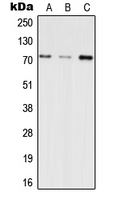Description:Rabbit polyclonal antibody to INPP5EImmunogen:KLH-conjugated synthetic peptide encompassing a sequence within the C-term region of human INPP5E. The exact sequence is proprietary.Purification:The antibody was purified by immunogen affinity chromatography.Clonality:PolyclonalForm:Liquid in 0.42% Potassium phosphate, 0.87% Sodium chloride, pH 7.3, 30% glycerol, and 0.01% sodium azide.Dilution:WB (1/500 - 1/1000), IF/IC (1/50 - 1/200)Gene Symbol:INPP5EAlternative Names:72 kDa inositol polyphosphate 5-phosphatase; Phosphatidylinositol 4,5-bisphosphate 5-phosphatase; Phosphatidylinositol polyphosphate 5-phosphatase type IV
Entrez Gene (Human):
56623;
Entrez Gene (Mouse):
64436;
SwissProt (Human):
Q9NRR6;
SwissProt (Mouse):
Q9JII1;
SwissProt (Rat):
Q9WVR1;
Storage/Stability:Shipped at 4°C. Upon delivery aliquot and store at -20°C for one year. Avoid freeze/thaw cycles.
-
 Western blot analysis of INPP5E expression in HEK293T (A), SP2/0 (B), H9C2 (C) whole cell lysates. (Predicted band size: 70 kD; Observed band size: 70 kD)
Western blot analysis of INPP5E expression in HEK293T (A), SP2/0 (B), H9C2 (C) whole cell lysates. (Predicted band size: 70 kD; Observed band size: 70 kD) -
 Immunofluorescent analysis of INPP5E staining in A549 cells. Formalin-fixed cells were permeabilized with 0.1% Triton X-100 in TBS for 5-10 minutes and blocked with 3% BSA-PBS for 30 minutes at room temperature. Cells were probed with the primary antibody in 3% BSA-PBS and incubated overnight at 4 °C in a hidified chamber. Cells were washed with PBST and incubated with a AF488-conjugated secondary antibody (green) in PBS at room temperature in the dark. Phalloidin - AF594 was used to stain Actin filaments (red). DAPI was used to stain the cell nuclei (blue).
Immunofluorescent analysis of INPP5E staining in A549 cells. Formalin-fixed cells were permeabilized with 0.1% Triton X-100 in TBS for 5-10 minutes and blocked with 3% BSA-PBS for 30 minutes at room temperature. Cells were probed with the primary antibody in 3% BSA-PBS and incubated overnight at 4 °C in a hidified chamber. Cells were washed with PBST and incubated with a AF488-conjugated secondary antibody (green) in PBS at room temperature in the dark. Phalloidin - AF594 was used to stain Actin filaments (red). DAPI was used to stain the cell nuclei (blue).
Induction of an alternative 5′ leader enhances translation of Inpp5e and resistance to oncolytic virus infection


 Datasheet
Datasheet MSDS
MSDS